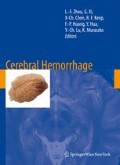Abstract
Intracerebral hemorrhage (ICH)-induced brain edema and neurological deficits are greater in aged rats than in young rats. Complement activation and neutrophil infiltration contribute to brain injury after ICH. In this study, we investigated the effects of aging on activation of the complement cascade and neutrophil influx following ICH.
Male Sprague-Dawley rats (3 or 18 months old) received an infusion of 100 mL autologous blood into right caudate. Rats were killed at 1,3,7, and 28 days after ICH and the brains were sampled for immunohis-tochemistry and Western blot analysis. Levels of complement factor C9 and clusterin were used as markers for complement activation, and myeloperoxidase (MPO) staining was performed to detect neutrophil infiltration. Western blot analysis showed that complement C9 and clusterin levels in ipsilateral basal ganglia after ICH were higher in aged rats than in young rats (p < 0.05). Immunohistochemistry showed there were more C9- and clusterin-positive cells around the hematoma in aged rats. However, MPO-positive cells in ipsilateral basal ganglia were fewer in aged rats (p<0.05) after ICH.
Our results suggest that ICH causes more severe complement activation and less neutrophil infiltration in aged rats. Clarification of the mechanisms of brain injury after ICH in the aging brain should help develop new therapeutic strategies for ICH.
Access this chapter
Tax calculation will be finalised at checkout
Purchases are for personal use only
Preview
Unable to display preview. Download preview PDF.
References
Cole DS, Morgan BP (2003) Beyond lysis: how complement influences cell fate. Clin Sci (London) 104: 455–466
Daverat P, Castel JP, Dartigues JF, Orgogozo JM (1991) Death and functional outcome after spontaneous intracerebral hemorrhage. A prospective study of 166 cases using multivariate analysis. Stroke 22: 1–6
Enzmann DR, Britt RH, Lyons BE, Buxton JL, Wilson DA (1981) Natural history of experimental intracerebral hemorrhage: sono-graphy, computed tomography and neuropathology. Am J Neuro-radiol 2: 517–526
Gong C, Hoff JT, Keep RF (2000) Acute inflammatory reaction following experimental intracerebral hemorrhage in rat. Brain Res 871: 57–65
Gong Y, Hua Y, Keep RF, Hoff JT, Xi G (2004) Intracerebral hemorrhage: effects of aging on brain edema and neurological deficits. Stroke 35: 2571–2575
Hua Y, Xi G, Keep RF, Hoff JT (2000) Complement activation in the brain after experimental intracerebral hemorrhage. J Neurosurg 92: 1016–1022
Jenkins A, Maxwell WL, Graham DI (1989) Experimental intracerebral hematoma in the rat: sequential light microscopical changes. Neuropathol Appl Neurobiol 15: 477–486
Morgan BP, Gasque P, Singhrao S, Piddlesden SJ (1997) The role of complement in disorders of the nervous system. Immunopharma-cology 38: 43–50
Wang J, Rogove AD, Tsirka AE, Tsirka SE (2003) Protective role of tuftsin fragment 1-3 in an animal model of intracerebral hemorrhage. Ann Neurol 5: 655–664
Wang J, Tsirka SE (2005) Tuftsin fragment 1-3 is beneficial when delivered after the induction of intracerebral hemorrhage. Stroke 36: 613–618
Xi G, Keep RF, Hua Y, Xiang J, Hoff JT (1999) Attenuation of thrombin-induced brain edema by cerebral thrombin preconditioning. Stroke 30: 1247–1255
Xi G, Hua Y, Keep RF, Younger JG, Hoff JT (2001) Systemic complement depletion diminishes perihematomal brain edema in rats. Stroke 32: 162–167
Xi G, Keep RF, Hoff JT (2006) Mechanisms of brain injury after intracerebral haemorrhage. Lancet Neurol 5: 53–63
Xue M, Del Bigio MR (2000) Intracerebral injection of autologous whole blood in rats: time course of inflammation and cell death. Neurosci Lett 283: 230–232
Yang S, Nakamura T, Hua Y, Keep RF, Younger JG, He Y, Hoff JT, Xi G (2006) The role of complement C3 in intracerebral hemorrhage-induced brain injury. J Cereb Blood Flow Metab 26: 1490–1495
Zhao X, Sun G, Zhang J, Strong R, Song W, Gonzales N, Grotta JC, Aronowski J (2007) Hematoma resolution as a target for intracerebral hemorrhage treatment: role for peroxisome proliferator-acti-vated receptor gamma in microglia=macrophages. Ann Neurol 61: 352–362
Author information
Authors and Affiliations
Editor information
Editors and Affiliations
Rights and permissions
Copyright information
© 2008 Springer-Verlag
About this paper
Cite this paper
Gong, Y., Xi, G., Wan, S., Gu, Y., Keep, R.F., Hua, Y. (2008). Effects of aging on complement activation and neutrophil infiltration after intracerebral hemorrhage. In: Zhou, LF., et al. Cerebral Hemorrhage. Acta Neurochirurgica Supplementum, vol 105. Springer, Vienna. https://doi.org/10.1007/978-3-211-09469-3_14
Download citation
DOI: https://doi.org/10.1007/978-3-211-09469-3_14
Publisher Name: Springer, Vienna
Print ISBN: 978-3-211-09468-6
Online ISBN: 978-3-211-09469-3
eBook Packages: MedicineMedicine (R0)

